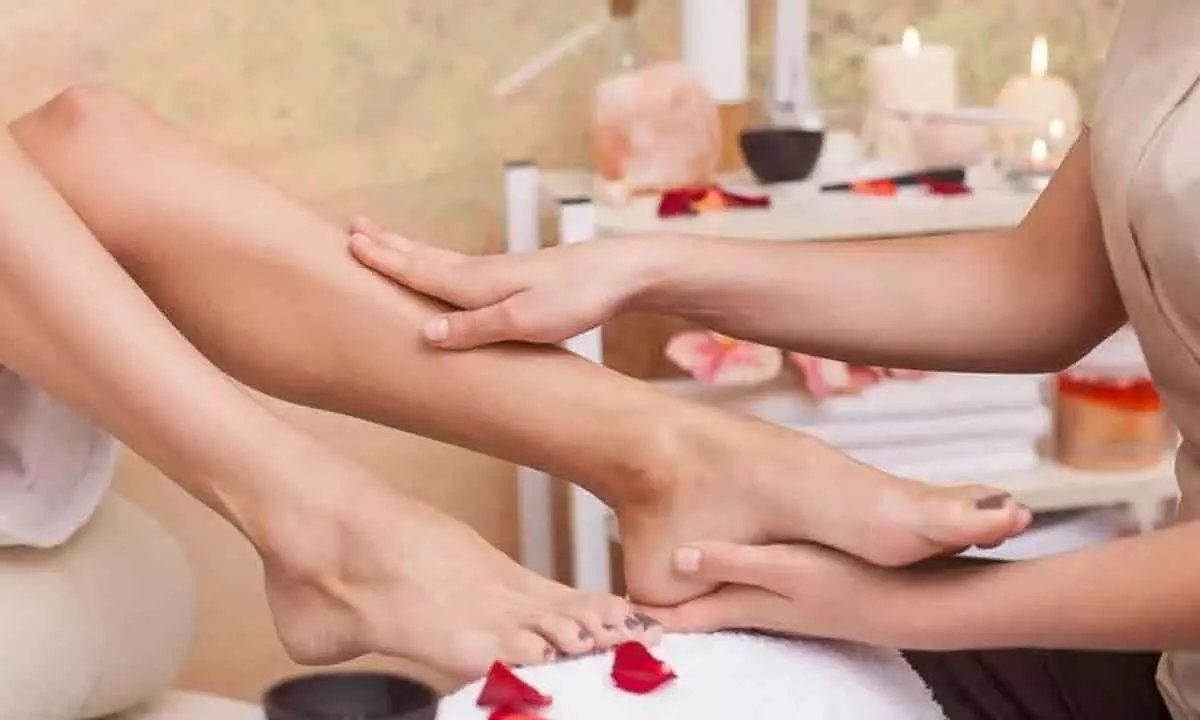The Coolest Winter Foot Care Tips

The skin of the feet is commonly thick and dry, and you need to follow a regular foot care regime dedicatedly to achieve beautiful and glowing feet
When it comes to skin and body care, our feet tend to be overlooked. The chilling winds of the winter season tend to make your feet dry, which can be hard on them. The skin on your feet is typically drier than the rest of the body, primarily because there are no oil glands underneath it to keep it naturally hydrated. Certain factors such as friction, pressure, diseases like eczema and advanced diabetes, and even old age can make your skin increasingly dry. Dry skin eventually leads to cracked heels, and ignoring the cracks will only worsen the situation. It is important to take certain precautions to ensure that your feet stay warm and dry. This is particularly important for those people in higher-risk groups, such as diabetics, those with poor circulation, who have medical conditions like Raynaud’s disease, or who may be more susceptible to damage from falls. Ultimately, your feet bear the full pressure of your life. It is your responsibility to at least pamper them occasionally to keep them silky and smooth. With just a little bit of care, you can be more comfortable and confident with your pretty feet. Here are the best foot care tips for winter:
1. The skin of the feet is commonly thick and dry, and you need to follow a regular foot care regime dedicatedly to achieve beautiful and glowing feet. Fill a foot tub with warm water and add ½ cup of Epsom salt to it. You can add some honey for an added layer of moisturisation. Soak your feet in this preparation for a few minutes until the water turns cold. Use a soft foot brush to scrub your feet lightly when the skin is soft enough from the soak. Dry your feet after the soak and put on a thick foot cream or an oil-based lotion to seal in the moisture.
2. Your feet have a blood supply that is affected by climate. “As the temperature fluctuates, the skin is left hot or cold. When your feet feel cold, it means the skin’s blood supply to the top layers of the skin has been reduced to preserve heat. A brilliant way to restore the heat is to use a foot cream in circular motions from the heel up to the toes. This will not only warm your feet but also moisturise them at the same time.”
3. An organic pedicure uses natural oils and products containing natural substances. Nowadays, foot spa treatments have also gained popularity. They can be combined with pedicures. Foot spa includes exfoliation and massage to reduce fatigue, tone the muscles, improve blood circulation, and induce relaxation. For a home pedicure, you will need a nail brush, pumice stone or heel scrubber, nail clippers, emery board, cotton wool, cotton buds, massage cream, polish remover, nail polish, and a small tub for soaking the feet. First, remove old polish if necessary with the remover, using cotton wool. Soak your feet in warm water, to which you should add some herbal shampoo and any vegetable oil, like sunflower oil or olive oil. You can also add coarse salt. Let the feet soak for 15 minutes. Then clean the nails with the brush. The brush should not be too hard. Use the pumice stone on the heels and sides of the soles. Avoid metal scrubbers. You can also scrub the entire feet with a rough towel or loofah. When this is done, wash the feet in clean water and dry with a towel.
4. If your nails need cutting, it’s better to use a nail clipper. Toe nails should be cut straight across. Avoid shaping toe nails as it can lead to ingrown nails. Use the emery board to smoothen them. Do not cut the cuticles of the toe nails. Do not use sharp instruments to clean the nails. Apply almond oil and push back gently with a cotton bud.
5. Love exfoliating your face, right? So, what’s the problem with your feet, boo? Exfoliation removes dead skin cells and preps the feet to better absorb skin treatments. Mix ground almonds with yogurt and some sugar. Apply them on the feet. After 15 to 20 minutes, rub gently on the skin with circular movements. Pay attention to the heels. Wash off with water. Then massage the feet with olive oil or sunflower oil. Wipe off excess cream with a moist towel. Mix one tablespoon each of lemon juice and honey with 50 ml rose water. Apply on the feet. Lie down and relax for half an hour. Wash it off with plain water.
6. Rice flour is a wonderful exfoliator that also repairs cracked heels and rough skin on the feet. Mix 2 tablespoons of ground rice flour, ½ tablespoon of honey, and 4–5 drops of lemon juice to make a thick paste. Soak your feet in warm water with Epsom salt to soften the skin, apply a layer of the paste, and massage for a few minutes to scrub the outer layer of skin. You can keep the paste on your feet for another 10 minutes to deep clean your skin. Wash the paste off with lukewarm water, and apply a thick lotion to seal the moisture.
7. Apply oil and massage on feet and nails. Pay special attention to the heels, applying more oil if needed. Use upward strokes for the massage, from the toes towards the ankles. Wipe the feet with a moist towel.
8. Mix a little lemon juice with honey and apply on the feet. Wash it off with plain water after 15 minutes. This moisturises and softens the skin.
9. If you wish to apply polish, put some cotton wool between the toes. Apply the nail varnish in broad strokes, from the base of the nail to the nail tips. After the first coat dries, apply the second coat of colour.
Once a week is more than enough, but make that twice if you’re cursed with super parched feet.















